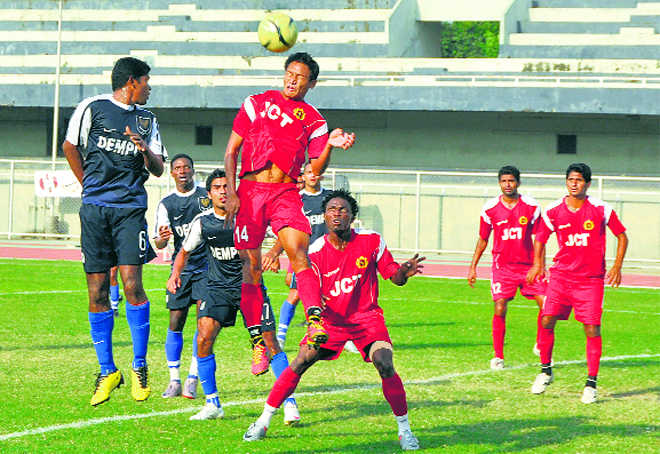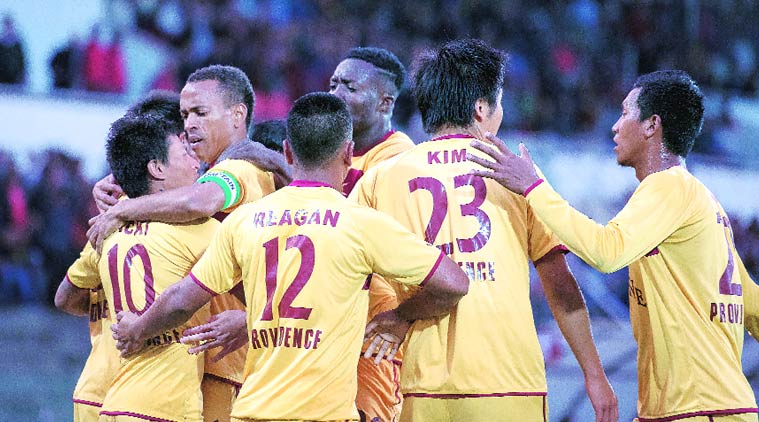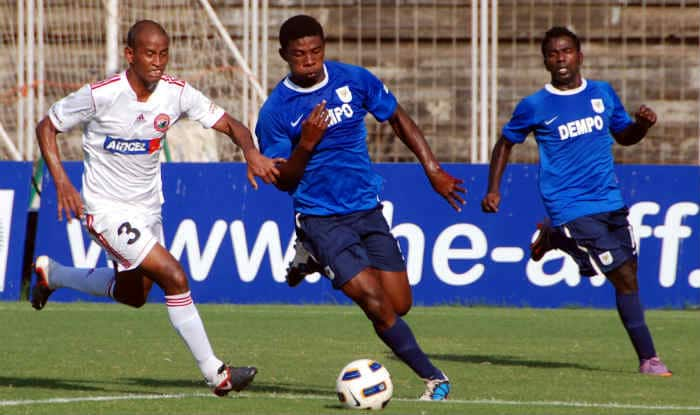Begin typing your search above and press return to search.
Featured
A look back into the dysfunctional clubs in the past decade of Indian football

The cloud of uncertainty looms large over the future of the I-League as Neroca FC, following the footsteps of Minerva Punjab, threatened to shut down if the All India Football Federation (AIFF) relegated them to the second division. The development comes a couple of days after Minerva Punjab owner Ranjit Bajaj announced that he would shut shop given the apathy of the AIFF towards the former I-League champions. Neroca FC’s Twitter handle tweeted on Monday, "After so much hard work and investment, we qualified for the top league (I-League) in 2017. Just after playing two seasons of it, we are put to play the second division once again. There is no other option than to shut down our beloved club."
 JCT FC monopolised the game in the state of Punjab for nearly four decades. The 40-year-old institution known for producing some of the best talents in the Northern belt of India highlighted the lack of eyeballs and the unprofessional environment in which the I-League was running. JCT FC ceased to operate after the 2010–11 I-League season due to lack of interest in football among Indians.
JCT FC monopolised the game in the state of Punjab for nearly four decades. The 40-year-old institution known for producing some of the best talents in the Northern belt of India highlighted the lack of eyeballs and the unprofessional environment in which the I-League was running. JCT FC ceased to operate after the 2010–11 I-League season due to lack of interest in football among Indians.
 In their I-League debut season, Royal Wahingdoh made quite a few heads turn. In 2015, the club saw an average attendance of around 10,000 at their home ground. Their stadium even saw a full house even when there was a hailstorm during a derby match against Shillong FC. They played the 2015 I-League season with an average of eight home-grown players out of 11. Though the club was granted a national license to compete in 2015–16 I-League, they decided to pull out, citing lack of a clear roadmap for the league as the reason. For Wahingdoh, which operated on a budget of Rs 6-7 crore in their only I-League season, it was about making a tough choice. Instead of pumping in more money into playing in a league where they got no recognition and no visibility, they chose to put the same money into building infrastructure, scouting for more talent.
In their I-League debut season, Royal Wahingdoh made quite a few heads turn. In 2015, the club saw an average attendance of around 10,000 at their home ground. Their stadium even saw a full house even when there was a hailstorm during a derby match against Shillong FC. They played the 2015 I-League season with an average of eight home-grown players out of 11. Though the club was granted a national license to compete in 2015–16 I-League, they decided to pull out, citing lack of a clear roadmap for the league as the reason. For Wahingdoh, which operated on a budget of Rs 6-7 crore in their only I-League season, it was about making a tough choice. Instead of pumping in more money into playing in a league where they got no recognition and no visibility, they chose to put the same money into building infrastructure, scouting for more talent.
 Dempo SC: One of the India's most successful clubs ever. The Golden Eagles, however, refused to accept the automatic promotion spot as second-place Minerva were offered corporate entry into the I-League. The club participates in the Goa Professional League currently.
Dempo SC: One of the India's most successful clubs ever. The Golden Eagles, however, refused to accept the automatic promotion spot as second-place Minerva were offered corporate entry into the I-League. The club participates in the Goa Professional League currently.
The Indian football team captain Sunil Chhetri last month voiced his support for smaller clubs plying their trade in the national domestic leagues and had urged that the interests of such clubs must be taken into account by the decision-makers while planning the course of Indian football. However, amidst the glittery and economically successful operation of the ISL, the focus on other leagues continues to deter every day.
The drama continues to unfold even after the AIFF president Praful Patel got his name registered in the higher echelons of Indian sports administrators by becoming the first Indian to be elected on the FIFA Council. The downfall of the I-League had already begun in 2015 when Pune FC and Bharat FC had to shut down operations owing to their relegations. I-League has always bear the brunt of the sacrifice Indian football has to make to keep running a marketable domestic league that people actually watch on television and in stadiums. While powerhouses IMG-Reliance and Star Sports back the ISL along with high celebrity value, the I-League has nothing to back it up but the AIFF’s support — which is clearly in favour of the ISL now. The league which only has a tradition as its backbone struggles to garner any attention. In the history of the I-League, many clubs have ceased to exist their team and had to shut down, eventually. Spiralling costs, limited media exposure and lack of fan following remain the significant factors that keep on haunting these clubs.The condition of the country's top division league, I-League remains in shambles as its future becomes more uncertain with the AIFF reportedly set to elevate Indian Super League (ISL) as the top tier league from next season.
Walking down the memory lane, many domestic clubs, despite their promising levels of football had to shut stop their operations.
JCT FC
Founded in 1971, the Jagatjit Cotton & Textile Football Club, often abbreviated as JCT FC was based out of Hoshiarpur in Punjab. Backed by Jagatjit Cotton and Textile Mills, under the aegis of Samir Thapar, JCT FC was one of the successful clubs during its time. The club grew to be the face of football in Punjab. The team was the inaugural champion of the National Football League back in 1996, winning the Federation Cup in the same year. When JCT shut down, the production of local players took a setback which in turn scaled down the the local connection with the sport. JCT FC monopolised the game in the state of Punjab for nearly four decades. The 40-year-old institution known for producing some of the best talents in the Northern belt of India highlighted the lack of eyeballs and the unprofessional environment in which the I-League was running. JCT FC ceased to operate after the 2010–11 I-League season due to lack of interest in football among Indians.
JCT FC monopolised the game in the state of Punjab for nearly four decades. The 40-year-old institution known for producing some of the best talents in the Northern belt of India highlighted the lack of eyeballs and the unprofessional environment in which the I-League was running. JCT FC ceased to operate after the 2010–11 I-League season due to lack of interest in football among Indians. Mahindra United
Mahindra United FC was one of the very few corporate teams in Indian football. Also known as the Jeepman for being a team by Mahindra, the club was started back in 1969 as the Mahindra & Mahindra Allied Sports Club. The Mumbai-based club got disbanded in 2010. Mahindra claimed the step was doled out to train school kids, aligned with the Mahindra Group's philosophy of developing sport at the grassroots. Being a corporate, Mahindra had a considerable budget to ply on, and they were spending a lot. However, they didn’t get their return on investment. Mahindra United was doing well nationally. They were two-time winners of the Federation Cup, having won the title in 2003 and 2005. The win in 2005 ensured that Mahindra became the first club in the history of Indian football to win the Federation Cup and National Football League double in the same season. Even after winning an I-League title, a Durand Cup and IFA shield, they ceased their operation in 2010.Royal Wahingdoh
Royal Wahingdoh started their journey in 2007 in the third division of the Shillong Premier League. Within a span of eight years, they made it to the I-League, and remarkably, finished third in their debut season. After a lot of trials, the club eventually made the cut for the temporary but necessary AIFF I-League club license. In their I-League debut season, Royal Wahingdoh made quite a few heads turn. In 2015, the club saw an average attendance of around 10,000 at their home ground. Their stadium even saw a full house even when there was a hailstorm during a derby match against Shillong FC. They played the 2015 I-League season with an average of eight home-grown players out of 11. Though the club was granted a national license to compete in 2015–16 I-League, they decided to pull out, citing lack of a clear roadmap for the league as the reason. For Wahingdoh, which operated on a budget of Rs 6-7 crore in their only I-League season, it was about making a tough choice. Instead of pumping in more money into playing in a league where they got no recognition and no visibility, they chose to put the same money into building infrastructure, scouting for more talent.
In their I-League debut season, Royal Wahingdoh made quite a few heads turn. In 2015, the club saw an average attendance of around 10,000 at their home ground. Their stadium even saw a full house even when there was a hailstorm during a derby match against Shillong FC. They played the 2015 I-League season with an average of eight home-grown players out of 11. Though the club was granted a national license to compete in 2015–16 I-League, they decided to pull out, citing lack of a clear roadmap for the league as the reason. For Wahingdoh, which operated on a budget of Rs 6-7 crore in their only I-League season, it was about making a tough choice. Instead of pumping in more money into playing in a league where they got no recognition and no visibility, they chose to put the same money into building infrastructure, scouting for more talent. Pune FC
Pune FC met with a similar fate like the Royal Wahingdoh. After finishing second in the I-League in 2012-13, the club owned by Ashok Piramal group shut shop in 2015. The academy that reared local youth talent was sold to ISL side Pune City, after the senior team playing at the Balewadi complex pulled out. The club had consistently been in the top five of the table since being promoted to the top division in 2009. However, they claimed to have been let down by the AIFF, where they clearly failed to see a road map for the I-LeagueBharat FC
Another club from Pune, Bharat FC was launched as the Kalyani Group-owned side gained corporate entry into the I-League for the 2015 season. But their performance was plagued by a miserable season. Despite investing heavily, Bharat FC just managed to gain only 18 points from 20 games. The return on investment being abysmal, the club didn’t see I-League as an economically viable investment anymore. With minimal activity ahead of their second season and several staff, including CEO Suvrat Thatte, resigning, the Pune-based club only played one season in the I-League.Mumbai FC
Staying in the I-League for a good 10 seasons, including second and first division, Mumbai FC was relegated after a dismal show 2016-17 season where they finished last with 13 points. The iconic club that had represented the Maharashtra capital in the top tier of Indian football started back in 2007 to bolster the opportunities for several young and upcoming players. Mumbai had looked to make a mark for themselves in the top division. Their iconic former coach Khalid Jamil had risen to fame at the club, as he steered the club clear of relegation for seven seasons while managing on a meager budget. Jamil’s departure in 2016 coincided with Mumbai’s relegation as their former head coach led Aizawl to the I-League title.DSK Shivajians
Founded initially as Shivajians Sporting club in Pune in 1987, it was referred to as a legacy team; a team from the grassroots of Pune. The take-over by Shirish Kulkarni, son of DS Kulkarni and the DSK group in 2010 brought about a sea change in the way the club functioned, intending to take it national. Narrowly missing out on an I-League spot via automatic promotion from the second division in 2013, DSK Shivajians entered the I-League via a corporate spot in 2015 which meant that there were immune from relegation in their first season. They finished 9th place on the points table in the first season and ended up in the 7th position next season under the aegis of Englishman Dave Rogers. However, financial trouble struck the DS Kulkarni group, the club pulled out of the next I-League season. Shirish and his wife were accused of scamming the money of many investors which tallied up to Rs 230 crore.Dempo
Dempo was undoubtedly India’s most successful club in the league era with five titles to its name. The club got relegated and won the I-League second division on their first try at promotion. Dempo SC: One of the India's most successful clubs ever. The Golden Eagles, however, refused to accept the automatic promotion spot as second-place Minerva were offered corporate entry into the I-League. The club participates in the Goa Professional League currently.
Dempo SC: One of the India's most successful clubs ever. The Golden Eagles, however, refused to accept the automatic promotion spot as second-place Minerva were offered corporate entry into the I-League. The club participates in the Goa Professional League currently. Salgaocar FC
Salgaocar had been one of India’s most successful clubs and the first Goan club to win the National Football League in 1999. They finished seventh in the 2015-’16 season but pulled out of the I-League citing an AIFF’s bias against the I-League teams. The 2011 I-League winners cited AIFF’s proposal to forcibly relegate all but three I-League clubs was a sign that the federation did nothing to protect the teams in their own competition.Sporting Clube De Goa
Another famous club from Goa pulled out of the I-League citing the same reasons as Salagaocar’s, by releasing a joint statement with them. Founded as Cidade de Goa, the club spent a combined ten seasons in the I-League and is a part of the Goa Professional League now. Their pull-out represented the absence of Goan clubs from the top tier until Churchill Brothers were re-instated.Rangjadied United
Mawphlang-based club Rangjadied United, formerly known as AR Hima, played one season in the I-League before they were ousted owing to not fulfiling the licensing criteria. The club finished 11th in the 2013-14 season but decided not to work on meeting the licensing criteria later, restricting itself to age group I-Leagues and the local SPL.The Indian football team captain Sunil Chhetri last month voiced his support for smaller clubs plying their trade in the national domestic leagues and had urged that the interests of such clubs must be taken into account by the decision-makers while planning the course of Indian football. However, amidst the glittery and economically successful operation of the ISL, the focus on other leagues continues to deter every day.
Next Story

